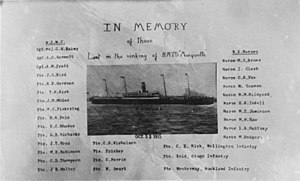SS Marquette (1897)
 A postcard in memory of the victims
| |
| History | |
|---|---|
| Name |
|
| Owner |
|
| Operator |
|
| Port of registry | London |
| Builder | Alexander Stephen and Sons, Glasgow |
| Yard number | 373 |
| Launched | 25 November 1897 |
| Identification |
|
| Fate | Torpedoed and sunk on 23 October 1915 |
| General characteristics | |
| Class and type | cargo steamship |
| Tonnage | 7,057 GRT |
| Length | 486 feet 6 inches (148.29 m)* |
| Beam | 52 feet 4 inches (15.95 m)* |
| Decks |
|
| Installed power | 770 nominal horsepower |
| Propulsion |
|
| Speed | 14 knots (26 km/h) |
| Range | Bunker capacity: 1,100 tons |
SS Marquette was a British troopship of 7,057 tons which was torpedoed and sunk in the Aegean Sea 36 nautical miles (67 km) south of Salonica, Greece on 23 October 1915 by SM U-35, with the loss of 167 lives,[1][2]
The ship was originally planned as the SS Boadicea, for the Wilson and Furness-Leyland Line, but was acquired by the Atlantic Transport Line shortly after completion to replace ships requisitioned during the Spanish–American War. She made a single voyage under the name Boadicea, and was renamed Marquette on 15 September 1898.
The total ship's complement was 741; 95 crew, 6 Egyptians, the No 1 Stationary Hospital (36 nurses, 12 officers and 143 other ranks), and the Ammunition Column of the British 29th Division (10 officers and 439 other ranks). There were also 491 mules and 50 horses on board.[3] Captain John Bell Findlay (born 1853 in Montrose, Scotland; died Essex 1938) was Master of the Marquette.[4] 29 crew, 10 nurses and 128 troops died in the sinking.[3] 32 of the dead were New Zealand nationals; 19 from the Royal New Zealand Army Medical Corps and 3 infantry attached to the Stationary Hospital (all other ranks) and 10 nurses in the Royal New Zealand Army Nursing Service. The 3 privates attached to the S.H. were medical orderlies.[5][6] The 1st (or No 1) New Zealand Stationary Hospital had been at Port Said, and returned to Egypt in March 1916, then went to Wisques in France.[7] Surgeon Hugh Acland survived the sinking.[8]
A naval Court of Enquiry was held on the protected cruiser HMS Talbot in Salonica Harbour on 26 October. The report, dated 3 November, found that no-one was at fault.[9]
The Stationary Hospital had been allocated to a troop ship by the British authorities, despite an empty British hospital ship, the Grantilly Castle having sailed on the same route on the same day from Egypt to the northern Greek port of Thessaloniki. The loss of nurses and medical staff led to the New Zealand government asking the War Office (via the Governor, Lord Liverpool) in November 1915 that transfers of medical staff be done by hospital ships where possible[10] Subsequent voyages of the 1st New Zealand Stationary Hospital were made in hospital ships.[11]
The names of the dead are recorded in the Mikra British Cemetery. The Nurses' Memorial Chapel at Christchurch Hospital in New Zealand commemorates the three Christchurch nurses who drowned.[12]
Notes
- ^ "BRITISH MERCHANT SHIPS LOST to ENEMY ACTION Part 1 of 3 – Years 1914, 1915, 1916 in date order". Naval History. Retrieved 21 January 2013.
- ^ Helgason, Guðmundur. "Ships hit during WWI: Marquette". German and Austrian U-boats of World War I - Kaiserliche Marine - Uboat.net. Retrieved 2 October 2012.
- ^ a b Smith 1990, p. 191.
- ^ Smith 1990, p. 116-120.
- ^ Smith 1990, p. 9.
- ^ Photo of memorial postcard with names
- ^ Smith 1990, p. 94f.
- ^ Maling, Peter B. "Acland, Hugh Thomas Dyke". Dictionary of New Zealand Biography. Ministry for Culture and Heritage. Retrieved 7 January 2012.
- ^ Smith 1990, p. 127–189.
- ^ Anniversary of sinking
- ^ Smith 1990, p. 190.
- ^ "Nurses' Memorial Chapel". New Zealand Heritage List/Rārangi Kōrero. Heritage New Zealand. Retrieved 5 March 2016.
References
- Smith, J M (1990). Cloud over Marquette. Auckland, NZ. ISBN 0-473-01081-X.
{{cite book}}: Invalid|ref=harv(help)CS1 maint: location missing publisher (link)
External links
- Newspaper report of Marquette Disaster
- Marquette Disaster in Nursing History
- List of ten nursing sisters lost
- Photo of Geoffrey Baker of Medical Corps drowned after torpedoing (wrongly refers to Marquette as H.S. or Hospital Ship)
- Mikra Memorial in CWGC cemetery Thessaloniki, Greece commemorating the deaths
